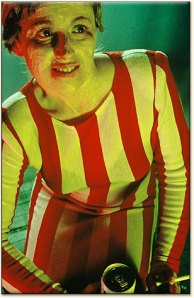[T]o be a woman is to be an object of contempt, and the vagina, stamp of femaleness, is devalued. The woman artist, seeing herself as loathed, takes that very mark of her otherness and by asserting it as the hallmark of her iconography, establishes a vehicle by which to state the truth and beauty of her identity.
—Judy Chicago and Miriam Schapiro, 1972
Judy Chicago is a feminist, artist, author, and educator and has been creating artwork since the mid 1960s. In 1970, Chicago founded the first Feminist Art program in the United States at the California State University in Fresno.
Judy Chicago, Dinner Party (1979)
This is an exhibit is a large table in a triangle shape. In previous times, women were not invited to the dinner table. They were not allowed to be creators of culture and this exhibit made a literal place for women in a table. Chicago took famous, influential women from the past and made a place from them in a table. Woman like goddesses, Emily Dickinson and other amazing woman that were not recognized in their own time. This is my favorite piece of work included in this blog. I love the creativity involved in the project and I also enjoy trying to visualize the conversation I would have with these amazing woman if I were sitting at this table. This is a very profound exhibition.
Judy Chicago, Birth Tear/Tear (1985)
Chicago’s Birth Project was made of dozens of images on the subject of birth and creation and embellished by needleworkers. This was a collaborative process that grew out of Chicago’s philosophy that people can be empowered by art – through making it, viewing it, and owning it. Exploring the subject of birth brought her face-to- face with the fundamental cause of women’s oppression – as soon as one gives birth to a child, one is no longer free. I have to agree with these statements in a sense. Giving birth is female empowerment. Showing is in an exhibition is powerful. I think the use of color in this particular piece shows the pain, power and peace that comes from giving birth.
Judy Chicago, International Quilting Bee (1980)
This exhibit by Chicago commemorates over 700 individual women and women’s organizations standing as a monument to womankind by honoring the accomplishments, personalities, individualism, and importance of women throughout history and the world. This idea is very similar to her Dinner Party exhibition in which it honors and commemorates powerful women. I like this piece because it was woven by different woman and brings a sense of culture and feminism into the project.
Miriam Schapiro is a Canadian born artist based in America. She is a pioneer of feminist art. She is also considered a pioneer of the Pattern and Decoration art movement.
Miriam Schapiro, The Poet #2, 1984
The textiles are used as symbolism of feminine labor. Schapiro coined the term “femmage,” which stands for the female laborer’s hand-sewn work. Schapiro comments, “I felt that by making a large canvas magnificent in color, design, and proportion, filling it with fabrics and quilt blocks, I could raise a housewife’s lowered consciousness.” She is known for her involvement in encouraging women to form support groups and emerge from isolation. I like the use of textiles as a creative and feminine form of art. I like that Schapiro included it in her works and made it such a beautiful form of femal expession.
Cindy Sherman is an American photographer, film director and best known for her conceptual portraits. Sherman has sought to raise challenging and important questions about the role and representation of women in society.
Sherman’s Untitled # 132 (1984) and Untitled # 138(1984) represent a fashion victim. She models in fashionable clothes by top designers. These clothes do not seem to feel comfortable and attractive. The woman is forced in a role where she loses her self-confidence and cannot bear the pressure of her forced role. Sherman’s choice of colors emphasizes the character of the woman. Therefore, in this feminist context, colors suggest pain, frustration and even threat. I find Sherman’s work to be very different. I enjoy viewing her photographs as they make me ponder what the meaning is behind them. Her photographs are art in pictures as she uses color and poses to convey feelings.
http://www.judychicago.com/about-judy-chicago/biography
http://smarthistory.khanacademy.org/1960-present-an-overview.html
http://throughtheflower.org/page.php?p=12&n=2
http://www.judychicago.com/image-gallery/birth-project
http://throughtheflower.org/page.php?p=11&n=2
http://www.albany.edu/museum/wwwmuseum/crossing/artist25.htm






Wow – I really enjoyed your blog. The way you used several seemingly unrelated styles and pieces of art and tied them all together under the Feminist Movement was very carefully and thoughtfully done. Great job with this assignment!
Very nice blog. I really enjoyed the diversity in the pieces and how you were able to relate them to one another. I found you did a great job analyzing these works and being able to relate them to the feminist art movement. I was glad to learn of these female artists it has been a change of pace since we study the past artists a majority of the artists we study are male. Great to study art done by females.